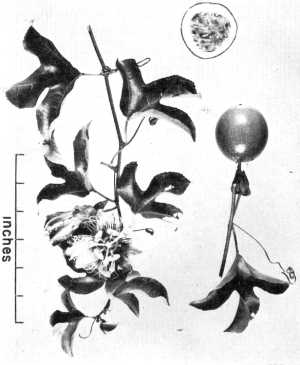Sunset®: 15-17,21-25,27
USDA: 9b-12
Frost Tolerance: Dies to the ground in Phoenix, root system hardy to 26°F (-3°C)
Sun Exposure: Full sun
Origin: Tropical Americas
Growth Habits: Semievergreen vine, up to 15 feet long (4.5 m)
Watering Needs: Regular to moderate water
Propagation: Seeds, cuttings
The Yellow Passion Fruit is one of several species of the genus -all woody, perennial vines native to the tropical Americas- that produce edible fruits. It is a fast-growing vine and is also suitable for ornamental screening purposes. The alternate curly leaves are deeply 3-lobed, and the vines climb readily by means of long tendrils in each leaf axil.
The yellow passion fruit is an excellent home fruit and offers great possibilities for commercialization in the American Tropics.
The Purple Passion Fruit (Passiflora edulis Sims) is extensively cultivated in Australia, New Zealand, South Africa, and the Levant. It has a flavor superior to that of the yellow type but has not grown well at Mayaguez (Puerto-Rico) due to a wilt disease, probably caused by a species of Fusarium, which kills the plants.
Blooming Habits:
The white flowers of the yellow passion fruit are 2 to 3 inches in diameter and are characterized by long, white, or white and purple, filament-like rays.
Fruiting Habits:
The fruits are globose to ellipsoid, attain a diameter of about 2 inches, and turn from green to yellow at maturity. The interior of the brittle-shelled fruit is filled with many small seeds surrounded by a yellowish, gelatinous, aromatic pulp and juice, which is used for flavoring sherbets and for making jams and jellies. The pulp also is eaten directly from the shell with a spoon after a little sugar has been added. The most popular use is in a refreshing drink prepared by blending the fruit pulp with ice, water, sugar, and a pinch of bicarbonate of soda. The juice is an excellent source of vitamin C.
Culture:
Plants of the yellow passion fruit grow well in a wide range of soils, but grow best on fertile well-drained types. The vines, which should be trained on a wire trellis or fence, produce flowers the second year after planting and set fruit continuously from June to November. Studies in Hawaii have shown that the insect most effective in pollen transfer is the large, black carpenter bee (Xylocopa varipuncta). Several species of this bee are found in the Tropics; their presence as pollinating agents should be encouraged. The vines produce for many years, require little attention other than occasional pruning and fertilizing, and are not affected by any serious diseases or insect pests.
Propagation:
The yellow passion fruit usually is propagated by seeds, which may be planted immediately after removal from the mature fruit. Seeds should be used from vines that have consistently produced a desirable type of fruit. Germination usually occurs in 2 to 6 weeks. Improved strains can be propagated vegetatively by 3-node cuttings of mature wood.
Desert-Tropicals is dedicated to provide gardening advice, gardening ideas, and information about flower of all kind for landscape and collections.We try to check carefully the identification of the plants on the illustrations as well as the other information from the page, but occasionally errors do occur. if you notice anything that needs to be changed please contact us.Thanks.
© 1998-2020 Philippe Faucon, All Rights Reserved.
